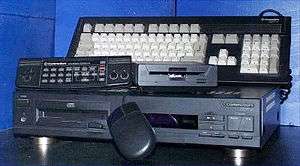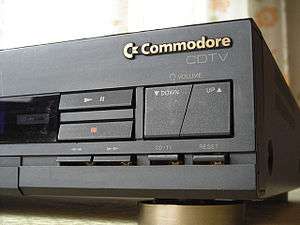Commodore CDTV
The CDTV (from Commodore Dynamic Total Vision, later treated as a backronym for Compact Disc Television) is a home multimedia entertainment and video game console – convertible into a full-fledged personal computer by the addition of optional peripherals – developed by Commodore International and launched in April 1991.[2]
 | |
 | |
| Manufacturer | Commodore International |
|---|---|
| Type | Home multimedia entertainment / Home video game console / Personal computer |
| Generation | Fourth generation |
| Release date | March 1991 |
| Introductory price | US$999 (equivalent to $1,875 in 2019) |
| Units sold | Germany: 25.800[1] UK: ~29.000 |
| Media | CD-ROM |
| Operating system | AmigaOS 1.3 |
| CPU | Motorola 68000 @ 7 MHz |
| Memory | 1 MB |
| Predecessor | Commodore 64 Games System |
| Successor | Amiga CD32 |
Description
The CDTV is essentially a Commodore Amiga 500 home computer with a CD-ROM drive and remote control. With the optional keyboard, mouse, and floppy disk drive, it gained the functionality of the regular Amiga.[3] Commodore marketed the machine as an all-in-one multimedia appliance. As such, it targeted the same market as the Philips CD-i. The expected market for multimedia appliances did not materialize, and neither machine met with any real commercial success. Though the CDTV was based entirely on Amiga hardware, it was marketed strictly as a CDTV, with the Amiga name omitted from product branding.
Commodore announced the CDTV at the summer 1990 Consumer Electronics Show in Chicago, promising to release it before the end of the year with 100 software titles.[3] The product debuted in North America in March 1991 (CES Las Vegas) and in the UK (World of Commodore 1991 at Earls Court, London).[4] It was advertised at £499 for the CDTV unit, remote control and two software titles.[5] The device was released in the United States for $999.[6]
In 1990 Computer Gaming World stated that Commodore had a poor reputation among consumers and developers, citing "abysmal record of customer and technical support in the past".[3] The company chose Amiga-enthusiast magazines as its chief advertising channel, but the Amiga community on the whole avoided the CDTV in the expectation of an add-on CD-ROM drive for the Amiga,[7] which eventually came in the form of the A570. This further hurt sales of the CDTV, as an A570-equipped A500 was electronically the same as a CDTV and, consequently, could run CDTV software, so there was very little motivation for an Amiga owner to buy a CDTV. Commodore would rectify this with CDTV's successor, the A1200-based Amiga CD32, by adding the Akiko chip, enabling developers to produce CD32 games that were playable only on the CD32. However, Nolan Bushnell, one of the chief endorsers of the CDTV, argued the system's high price alone was enough to explain its market failure: "... it's very difficult to sell significant numbers of anything at more than $500. ... I felt that I could sell a hundred thousand of something that costs $800 standing on my head. I thought that it would be a no-brainer. And I can tell you that the number of units that we sold in the U.S. at $800 you could put in your eye and not draw tears."[8]
The CDTV was supplied with AmigaOS 1.3, rather than the more advanced and user-friendly 2.0 release that was launched at around the same time. Notably, the CDXL motion video format was primarily developed for the CDTV, making it one of the earliest consumer systems to allow video playback directly from CD-ROM.
By 1994 Computer Gaming World described the CDTV as a "fiasco" for Commodore.[9] Though the company later developed an improved and cost-reduced CDTV-II, it was never released.[10] Commodore discontinued the CDTV in 1993 with the launch of the Amiga CD32, which again was substantially based on Amiga hardware (in this case the newer Amiga 1200) but explicitly targeted the games market.
Design

The CDTV was intended as a media appliance rather than as a mainstream personal computer. As such, its housing had dimensions and styling that were fairly comparable to most household stereo system components of the period, and it came with an infrared remote control. Similarly, it was initially sold without a keyboard or a mouse (which could be added separately, and were later bundled with the machine). The CDTV was based on the same technology as earlier Amiga systems, but featured a single-speed CD-ROM drive and no floppy disk drive as standard.
Technical specifications

| Attribute | Specification |
|---|---|
| Processor | Motorola 68000 at 7.16 MHz (NTSC)[a] or 7.09 MHz (PAL)[b][c] |
| RAM |
|
| ROM |
|
| Chipset | Original Chip Set (OCS) Enhanced Chip Set (ECS) |
| Video | |
| Audio | |
| Removable storage | Single-speed CD-ROM drive (proprietary controller) |
| Input/output ports |
|
| Audio/Video output | |
| Expansion slots |
|
| Operating system |
|
| Physical dimensions | 430 × 330 × 95 mm (width × depth × height) |
| Other |
|
Official upgrades
The CDTV is compatible with many Amiga peripherals from the same period. In addition, official CDTV peripherals and upgrades included:
- Wireless infrared mouse (CD1252)
- Wireless trackball
- Black styled keyboard
- SCSI controller providing both an internal and external SCSI connector for hard disk drives and other SCSI devices
- External black styled hard disk drive[11]
- External black styled floppy disk drive (CD1411, an FB-354C)
- Proprietary memory cards with a capacity of 64 or 256 kB (CD1401/CD1405) allowing storage of game scores and progress[12]
- Genlocks for NTSC or PAL (CD1300/CD1301) to overlay video signal with a secondary video source[13]
Versions
- CDTV: CDTV unit and remote control/gamepad
- Pro pack: CDTV unit, remote control/gamepad, keyboard, mouse and floppy disk drive, along with Almathera CDPD Public domain software compilation on CD-ROM
Market competition
High-end A/V (primary market)
(multi-purpose audio/video systems)
- Philips' CD-i
- Pioneer's LaserActive
- Tandy Video Information System
Video gaming (secondary market)
- NEC PC Engine with Super CD-ROM expansion
- Nintendo's SNES
- Sega Mega Drive with CD-ROM expansion
- The 3DO Company's 3DO Interactive Multiplayer
See also
References
- https://distrita.com/amiga-sold-in-units-by-commodore-in-germany-revealed/
- Feldman, Tony (1994). Multimedia. Psychology Press. ISBN 9781857130102.
- "The Maturation of Computer Entertainment: Warming The Global Village". Computer Gaming World. 1990-07-08. p. 11. Retrieved 16 November 2013.
- "The Commodore CDTV Information Center - www.cdtv.org.uk". Archived from the original on 2009-04-12. Retrieved 2010-08-06.
- "Amiga History Guide".
- Beaver County Times-Apr5th,1991-Commodore puts computer into TV.
- http://tidbits.com/article/3515
- "What the Hell has Nolan Bushnell Started?". Next Generation. Imagine Media (4): 9. April 1995.
- Miller, Chuck; Dille, H. E.; Wilson, Johnny L. (January 1994). "Battle Of The New Machines". Computer Gaming World. pp. 64–76.
- "The Big Book of Amiga Hardware - Commodore CDTV-II".
- "The Commodore CDTV Information Center - www.cdtv.org.uk".
- "CDTV Technical Information by Darren Ewaniuk".
- "The Big Book of Amiga Hardware - Commodore CD1300".
External links
